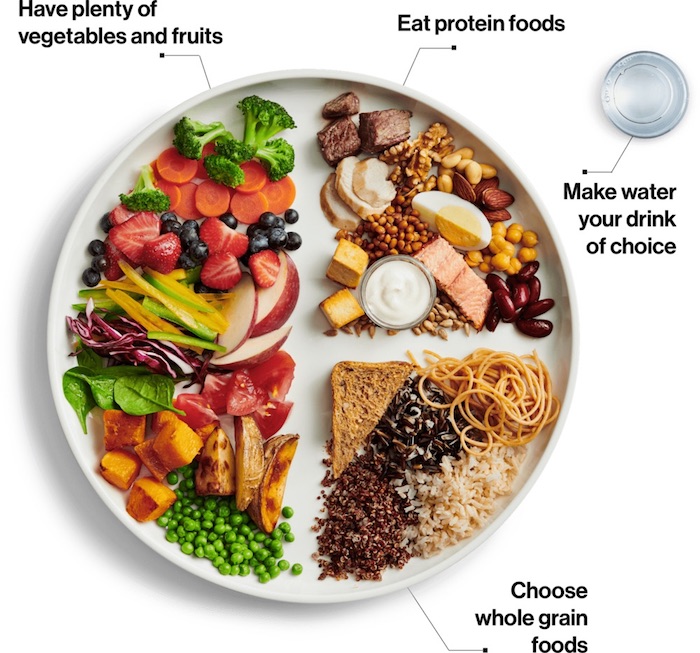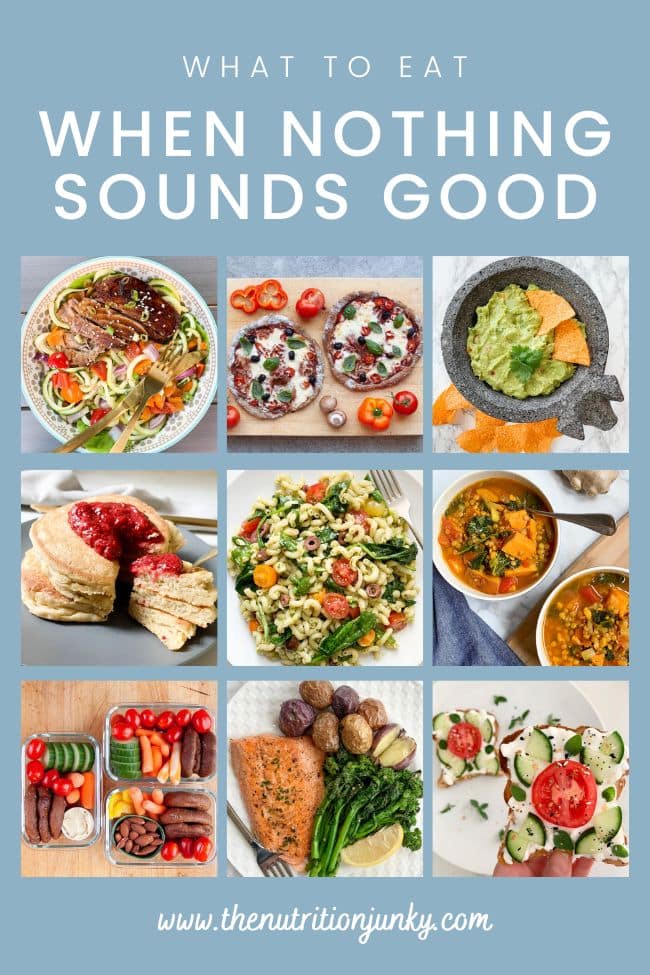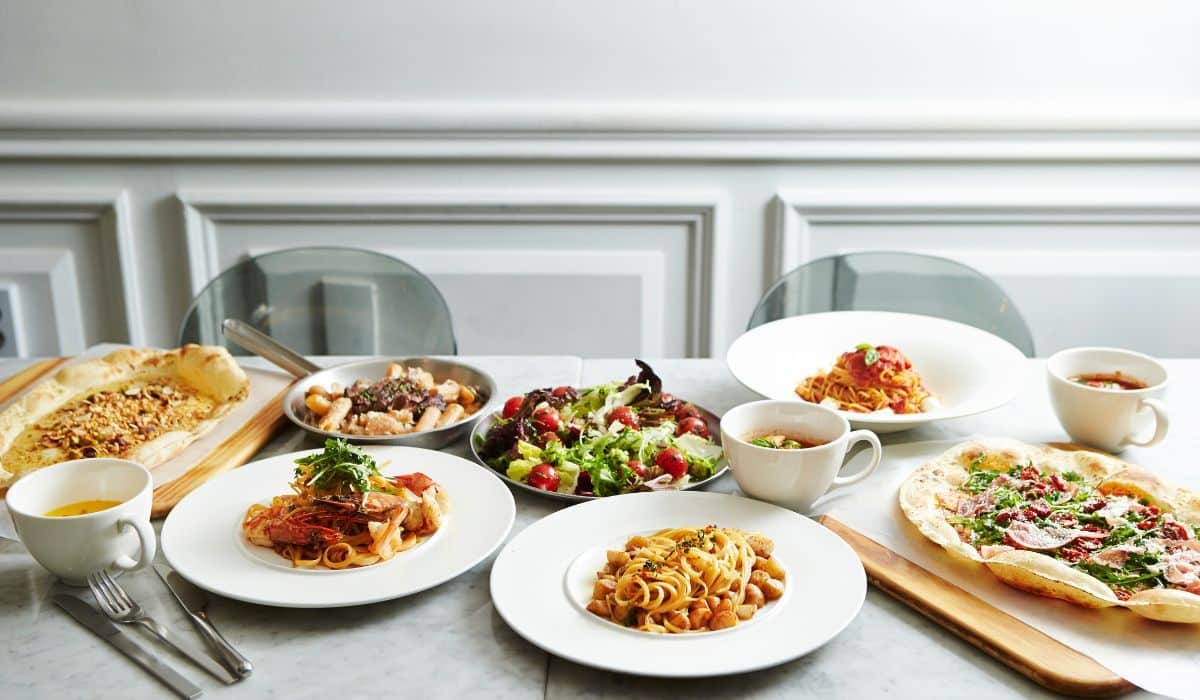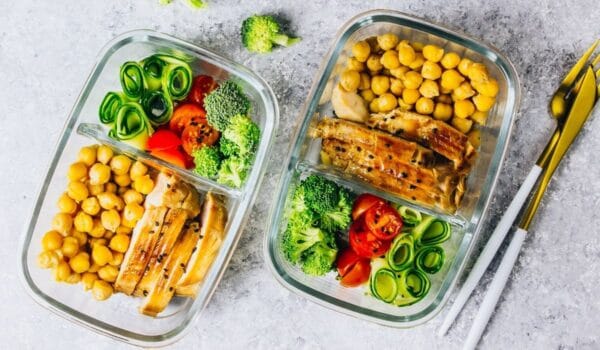You go grocery shopping and buy a week’s worth of food. But midweek you can’t stand the thought of eating what you had planned. This article and ultimate foods list will help you understand why this happens and inspire you to decide what to eat when nothing sounds good!
If you buy from one of the links in this post, I may earn a commission. Visit my Privacy Policy for more information on affiliates.
Why nothing sounds good to eat
So, you’re hungry but nothing sounds good enough to eat? Let’s unpack a few reasons why this might happen.
1. You’ve overdone it or developed an aversion
You may have overdone it. Perhaps you fixated on a specific food for a while and the novelty has worn off.
If you have ever found yourself physically repulsed by a certain food, you may have even developed an aversion to it.

What is a food aversion?
An aversion is a strong dislike for something. In this case, that “something” is a certain food or element of a food. This can include its smell, taste, texture, any sounds or even visual components associated with it.
There is no scientific explanation for why an aversion develops (yet). But an unpleasant experience with food, like with food poisoning, may increase the likelihood that one develops. Here, the aversion acts as a biological defense mechanism against future food poisoning.
So the body basically safeguards itself from getting sick again. Isn’t the human body the coolest?
Aversions are also more common in certain populations, such as during pregnancy and in neurodivergent populations. Individuals with Autism Spectrum Disorder and/or Attention Deficit Hyperactivity Disorder (or ADHD) are more likely to experience sensory aversions to foods. This may limit certain textures, smells, etc. in their diet.

Avoidance of the trigger food is usually the solution. However, if the aversion impacts your quality of life, there are certain strategies and therapies that may help. But that’s a blog post for another day.
As long as you can find other foods you enjoy, there is no problem here!
2. You don’t feel like cooking
Cooking takes a lot of time, effort, executive function and skill. After a long day of work, takeout might seem like the best option. And there is nothing wrong with that!

But for a lot of us, this isn’t financially sustainable long term. Keeping a list of simple and delicious staple recipes can be helpful for when we are in the mood for a low effort meal. For example, this Pesto Pasta Salad is one of my favorites.
It is also good to have some frozen foods on hand. Burritos, chicken strips, falafel, or microwave dinners are some easy options. Things that require little to no preparation are key.
3. You waited until you were too hungry
Making an elaborate meal when you are already hungry can feel like a daunting task. You might lack energy or inspiration and may even feel a bit irritable. Even deciding what to eat when you reach this point can be tough.
It might be too late this time round, but you can avoid this feeling in the future by checking in with yourself more frequently. It’s also good to have food on hand for when hunger strikes.
Channeling the intuitive eating concept of practical hunger can be helpful. This is when you eat before you feel physically hungry to avoid anticipated hunger in the near future.

An example of practical hunger is having a snack right before a lunch meeting (and before you’re feeling hungry). This is considered practical hunger because you are eating to avoid physical hunger while you are in the meeting.
Implementing this skill and meal planning will help you make food decisions before you feel ravenous or overwhelmed.
4. Medical condition, illness or medication
Underlying health conditions and medication side effects are less common, but may also impact appetite.
Conditions like anxiety, depression, hypothyroidism, zinc deficiency or morning sickness can impact taste buds and the desire to eat. As well as some more short-lived illnesses like food poisoning, a cold or the flu.
Certain prescribed medications may also affect your appetite or the way you feel hunger in the body. For instance, certain stimulant medications prescribed for ADHD decrease appetite and may promote associated weight loss. This may reduce the amount of food an individual eats while on the medication. However, some people may experience the desire to binge eat once the medication wears off.

We have only briefly touched on this topic. There are a variety of other conditions and medications that may curb your appetite.
If you think you are experiencing any of the above or feel your appetite has changed, please talk to your medical provider.
5. You lack inspiration
You are STILL hungry but nothing sounds good? Perhaps you’re creatively drained or you just can’t put a finger on what you are craving.
Regardless of the reason, you might need some inspiration.
Check out the list below. If any of the items appeal to you, add them to your recipe roster!
How to create a satisfying meal plan
A quick tip before we dig into the list: the most physically satisfying meals tend to include a carbohydrate, fat and protein. Keep this in mind as you create your meal…but don’t overthink it.
Following the food guide format tends to hit all the macronutrients needed.

“Healthy eating” looks different for everyone. Some meals will be nutritionally balanced and others won’t be. Either way, if you can stomach something more nutrient-dense (with protein and/or fibre to keep you feeling full longer) then you are off to a good start.
Use your intuitive or mindful eating skills to cess out exactly what it is you want. Identify what flavors and textures you find appetizing and focus on those for now. After all, eating something is better than nothing.
What to eat when nothing sounds good
Below are some food options and beneath them are some add-ons or toppings you can add to make them a bit more nutritionally balanced. It’s like a choose-your-own-adventure kind of thing.
This list doesn’t consist of unfamiliar or complicated ideas, but rather easy inspiration for when you need it.
Sweet foods
- Protein smoothie
- Yogurt with granola and fruit
- Cereal
- Oats
- Waffles or pancakes
- Muffins
- Chia pudding
- Banana with peanut butter
- Apple or grapes with cheese
ADD: nut butters, nuts, fruit, oats or cereal, chia seeds, flax seeds, yogurt or dairy alternative
Savory foods
- Crackers and cheese
- Crackers and tuna or egg salad
- Adult lunchable with cheese, crackers, veggies and charcuterie meats
- Quesadilla
- Pasta with pesto or tomato sauce
- Stuffed peppers
- Zucchini boats
- Microwave sweet potato with toppings
- Frozen veggie stir fry
- Bean salad
- Pasta → mac and cheese, ravioli, pasta salad
- Mashed potatoes with frozen veggies
- Veggies and dip
- Pita and hummus
- Nuts
- Eggs → omelet, scrambled, poached, etc.
- Grilled cheese
- Tuna and cheese melt
- Sandwich, wrap or panini → egg, tuna, lunch meat, peanut butter, etc.
- Breakfast sandwich with egg and cheese
- Bagel with cream cheese
- Regular or veggie burger
- Canned or homemade soup and toast
- Ramen with veggies and an egg
- Sushi bowl
- Grain bowl with veggies
- Chicken strips
- Frozen burrito
- Frozen pizza
- Frozen pot pie or shepherd’s pie
- Nacho chips with salsa and/or guacamole
- Loaded nachos
- Popcorn with butter and nutritional yeast
- Mashed avocado on toast
ADD: cheese, cream cheese, hummus, smoked salmon, avocado, luncheon or other prepared meat, canned tuna or salmon, beans, veggies, salsa, guacamole, nutritional yeast, fresh, frozen or canned veggies
And last but not least…takeout!
Not every meal you eat will be nutrient-dense or super satisfying. And that’s okay! You will have MANY more opportunities to eat, trust me.
I hope you enjoyed this article on what to eat when nothing sounds good!
Have something to add to this list? Please comment below.
If you’re interested in learning more about meal planning with ADHD, check out my meal plan guide. It includes a FREE weekly meal planner.







Ahhhhh I need help I don’t know what to eat
I hope my suggestions provide you with some inspiration!
Thank you you are helping me lost my husband lost my interest in food will start some of what you say Del x
Sending you love <3 don't forget to take care of yourself
Is there a class of flavors that appeals to people that don’t want to eat?
Often more plain starchy carbs…toast, cereals, noodle soup, etc.
Age 94 completing cancer radiation process. Wife prepares food that sounds good but stops being edible after a couple bites. Any helpful ideas?
Smaller but more frequent meals may help <3
Wow! Great article! So much terrific information. I can relate to everything! Thanks for putting this information all together for a super educational and useful read